When Jackie and I eat cauliflower, it is rarely as a side dish: It is often our whole dinner. I’m not sure why; perhaps because a cauliflower is just so damned big that it looks like a main course – and because its uniform pleasantness somehow never grows boring. Sometimes we have it with cheese sauce (on which I wrote a few years ago – and vented about an expression I find irksome); sometimes as a curry, either faux-Indian or faux-Thai (most of my Asian cooking merits that “faux” disclaimer).
Once a year at least, though, we eat our cauliflower cut into pieces and baked with a crisp breadcrumb-and-parmesan coating, and that’s how we had it last week after a visit to the farmers’ market. It’s easy to make: You cut up a head of cauliflower, par-cook it, egg-and-breadcrumb it, and bake it drizzled with oil or butter. But as I describe the cooking, I’ll pass along a couple of tricks that help make it a dish we return to year after year.
I begin by snapping off any leaves and stems surrounding the white curd (as it is called by gardeners). Sometimes I save them, because they’re a decent thing to eat once they’ve been cooked to tenderness; sometimes I get rid of them. I then cut the cauliflower into large florets, cutting through the stalks then easing off chunks by hand. Now, here’s the first trick: when you cut the chunks into the desired bite- or two-bite-sized pieces, be sure to leave a flat surface by cutting through the stalk lengthwise. Once breaded, this will rest against the baking sheet and become particularly brown and crusty. Generally, I’ll use about two thirds of a medium-large cauliflower (about the size of the ones you see in the supermarket) and save the rest, uncooked, for the next day. (This time, I cut it smaller, simmered it and dressed it with oil, vinegar, salt and a mixture of crushed spices: pepper, caraway, cumin, coriander and fennel, a blend I’d used for a duck dinner a while before).
Having turned the oven on to just shy of 400º F (205º C), I par-cook the cauliflower, and here there are choices to be made: you can either boil the pieces in salted water or you can steam them. My preference is to steam them, because the chunks could possibly break in the tumult of even slowly boiling water. The bigger choice is how long to cook them, bearing in mind that they will spend half an hour in the oven. If you steam them for a minute, the end product will retain more texture: it won’t be crunchy, but it will offer token resistance to the knife or tooth. But if you cook until almost but not quite tender – say, four minutes – the baked morsels will be very soft under their crust, almost custardy in fact, which has its own, very different, appeal. You could cook some for a minute and some for three or four and do a half-and-half platter. Last time, I went the custardy route, though typically I aim for more texture, as I think most people would do.
Whether the cauliflower has been boiled or steamed, it must now be allowed to cool and – most important – dry to stop the coating from sliding off. A colander will work, but not as well as a wire rack on which you can spread the pieces in a single layer. While it’s cooling, I beat two eggs in a large bowl with two tablespoons of flour to form a light batter, and that is the second trick. The usual sequence for breading food is to flour it, then run it through an egg wash, then coat it in crumbs. But with something like a cauliflower floret, the flour will tend to gather in the gaps and mix with residual moisture to create a pasty unpleasantness. Flour-thickened egg will adhere reasonably well without that danger. I also combine a heaping cup (say, 260 ml by volume) of non-flavored breadcrumbs with half a cup of grated parmesan, seasoning it also with salt and pepper. A dry-leafed herb such as thyme or rosemary, finely chopped, can also be added; so can a quarter teaspoon of cayenne or other hot chili powder.
Prepare a baking sheet by smearing it generously with either olive oil or melted butter (I almost always use oil). Before greasing, I line mine with a piece of parchment paper (greaseproof paper in the UK), which makes it easier both to remove the finished cauliflower and to clean the pan.
Now, the florets are cool enough to handle. I put four or five pieces in the egg mixture, using a rubber spatula to turn them in the liquid and ensure that they are well doused. These go next into the breadcrumb mixture to be thoroughly coated. Another trick: When you lift them (by hand) from the crumbs to the greased baking sheet, try to include more crumbs than are actually sticking, because these will come together and form a good crust in the oven thanks to both the egg mixture and the cheese.
Be sure to place them on the sheet flat side down, but don’t worry if some pieces don’t have a flat side: this happens. Finally, drizzle them with olive oil or melted butter, making sure there’s some on each piece.
Bake them for 30 or 40 minutes until the bottoms are deep golden brown and the tops crisp and golden. Check after 15 minutes and if necessary turn the oven down by a few degrees. If you have a broiler (I don’t – a long story), you might deploy it to darken the color so long as you’re careful not to scorch the crumbs. There will be stray browned crumbs on the baking sheet; you can, if you like, sprinkle them over the cauliflower pieces when you dish them up.
Jackie and I often eat these as they are, but sometimes there’s a sauce for dipping or spreading. Last time there were two: Leftover tomato sauce (just fresh ripe tomatoes cooked with oil and mint leaves), and a Special Sauce we sometimes spread on hamburgers (2/3 mayonnaise out of a jar and 1/3 Momofuku Ssäm Sauce, which you can and should buy on line).
These are great fun, with their easygoing flavor and textural contrasts. You could serve them with drinks, but I still maintain they make a grand meal. Just be sure to have some dessert at the ready: Cauliflower, even breaded and even in large quantity, doesn’t exactly stick to your ribs.

A whole dinner’s worth of crisp, breadcrumb-and-parmesan baked cauliflower
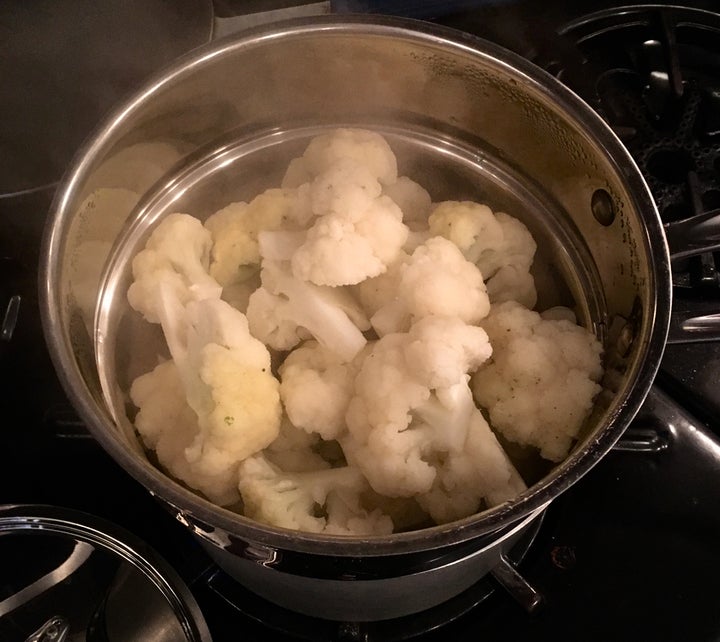
How long to steam the cauliflower depends on what result you wish: merely tender or almost custardy
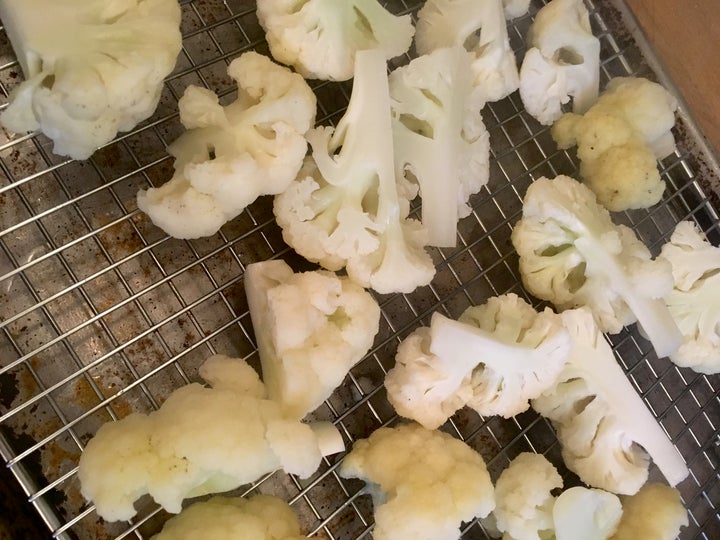
Let the steamed cauliflower dry - preferably on a rack - before breading
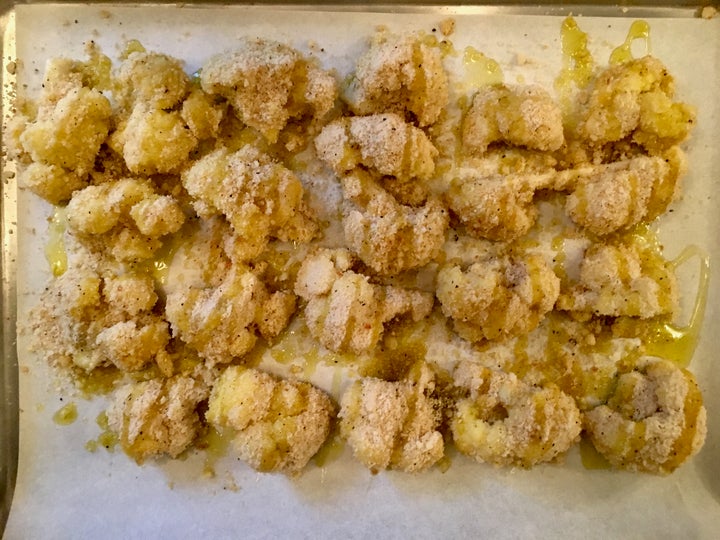
Be liberal with the coating and with the olive oil (or melted butter)
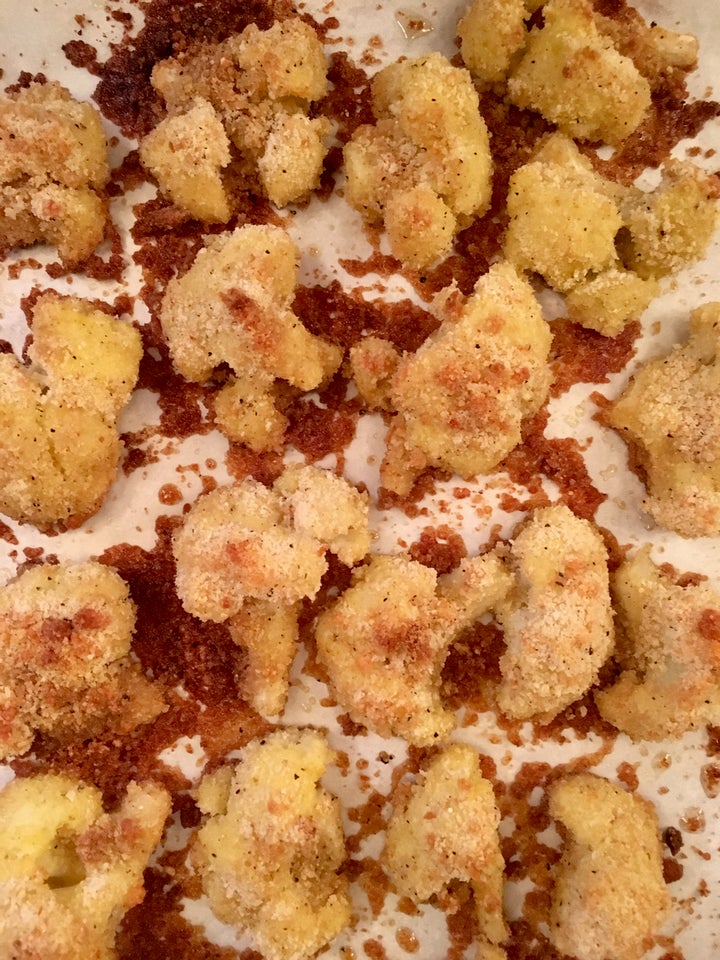
After 30 minutes in the oven

The flat bottom surfaces will brown particularly well
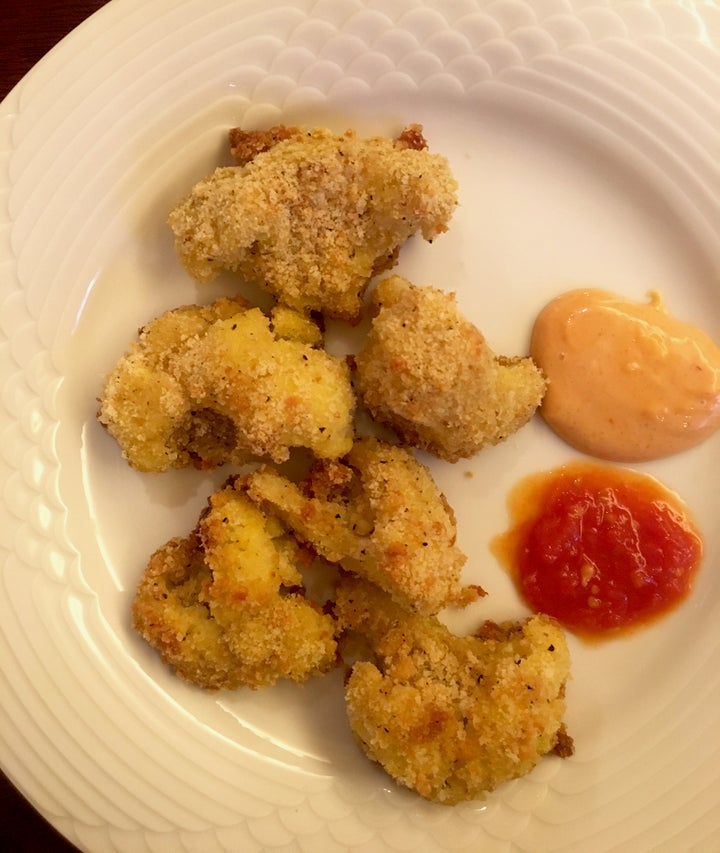
Almost any sauce will be successful; go ahead and use two or three
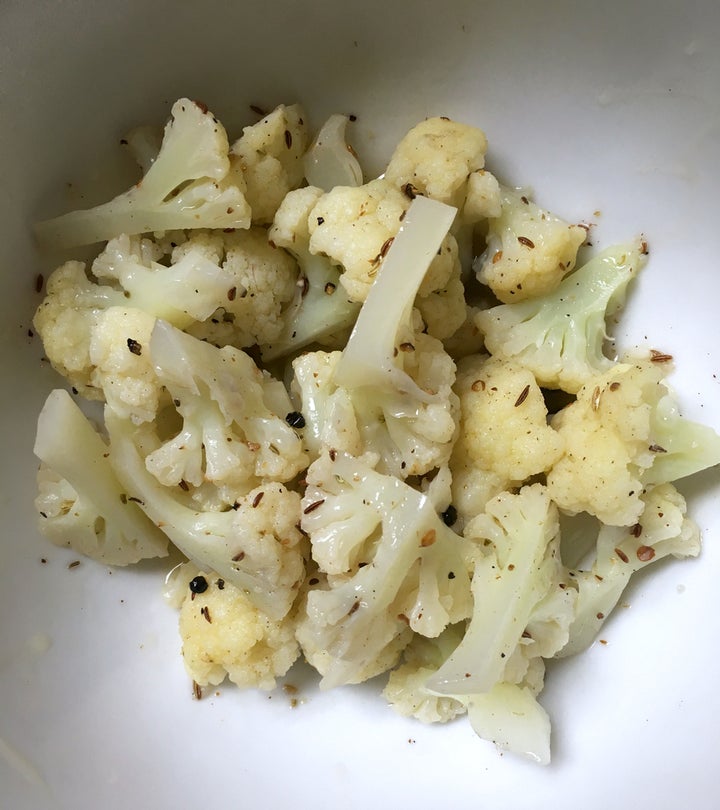
Unused cauliflower can be steamed (or boiled) and treated as you might treat potatoes for a salad: Oil, vinegar, spices.